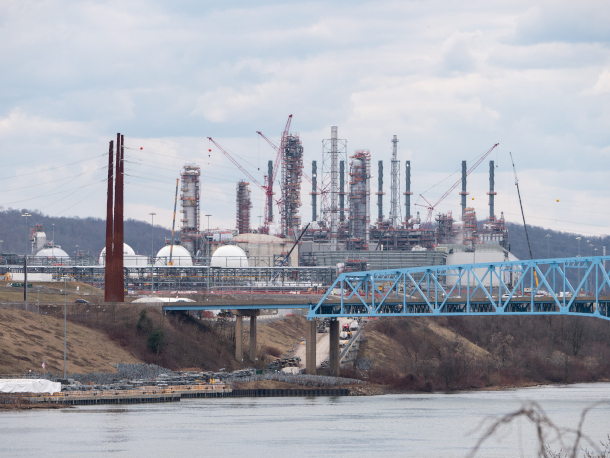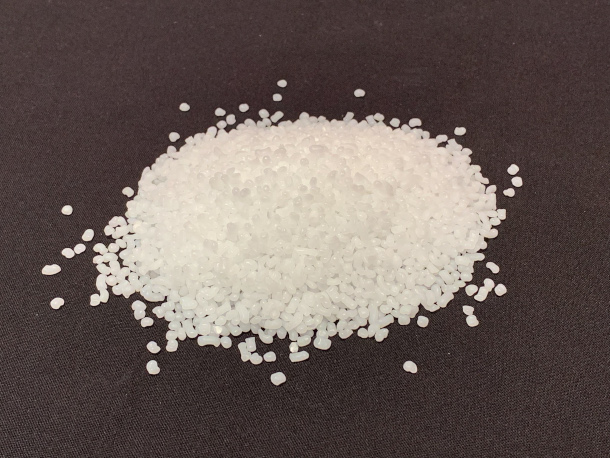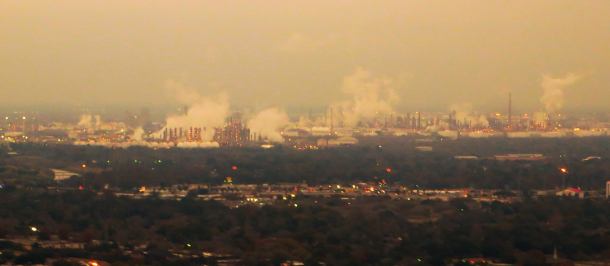Cleaning Up Toxic Air
Air Date: Week of April 14, 2023

The massive Shell Ethane Cracker Petrochemical Plant in Beaver County makes plastic from locally fracked natural gas. The Environmental Integrity Project and Clean Air Council filed a notice of intent to file a lawsuit against the Shell cracker plant. They say the plant has violated the federal Clean Air Act and other environmental laws. (Photo: Mark Dixon, Flickr, NoPetroPA, CC BY 2.0)
The EPA is proposing to cut the amount of toxic air pollutants industrial sources are allowed to emit. The targeted chemicals include known carcinogens that have long contaminated communities in Appalachia and Louisiana’s “Cancer Alley.” Judith Enck, founder of Beyond Plastics and a former EPA regional administrator, joins Host Jenni Doering to discuss.
Transcript
O’NEILL: From PRX and the Jennifer and Ted Stanley studios at the University of Massachusetts, Boston, this is Living on Earth. I’m Aynsley O’Neill.
DOERING: And I’m Jenni Doering.
Much of our show today highlights the pollution consequences of plastic production, and as we were preparing for broadcast news broke of a massive industrial fire at a plastics recycling plant in Richmond, Indiana. The facility has had many safety violations in the past, with plastic waste piling up creating a fire hazard. A black plume of smoke carrying toxic chemicals from burning plastic has blanketed the area, creating serious health concerns from exposure to known carcinogens. Much like the East Palestine, Ohio train derailment that led to the burning of toxic chemicals, the Indiana event is top in the news cycle. But nearly every day the petrochemical industry emits some of the same hazardous air pollutants that officials are concerned about with these dramatic events. That’s why it’s significant that The Biden administration recently proposed a new regulation aimed at reducing hazardous air pollutants from petrochemical plants. If adopted, the EPA says the new rules will reduce the amount of toxic air pollutants released each year by more than 6,000 tons. Proponents say it would be a tremendous win for public health by reducing chemical exposure that leads to many cancers including lymphoma, leukemia, and breast cancer. The proposed rule would be especially beneficial for communities in Appalachia and Louisiana’s Cancer Alley, which are already burdened with dipropionate chemical exposure and associated health problems. For more I’m joined now by Judith Enck, founder of Beyond Plastics and a former EPA regional administrator. Welcome back to Living on Earth Judith!
ENCK: Thanks, Jenni, it's really good to be with you.
DOERING: What are these hazardous air pollutants that the Biden administration has proposed to address? Can you walk us through some of them and what we know about the negative health effects that are linked to?
ENCK: Sure. So this proposed regulation would cover over 200 industrial facilities. Places like factories that make plastics or oil refineries and EPA believes that they can cut the toxic air emissions of dozens of different air toxics. Some that they are particularly focused on are ethylene oxide that has been linked to lymphoma and leukemia. Second, they are looking at chloroprene, which is well known for being used at a facility in Louisiana called Denka and in 2016, EPA identified the area around that facility as having the highest cancer rates in the entire United States.
DOERING: Wow.
ENCK: EPA is also targeting 1,3-butadiene, which is causes lymphoma and leukemia, they're targeting benzene, ethylene dichloride and perhaps in my mind most importantly, they're targeting vinyl chloride. Vinyl chloride is linked to liver cancer and many other health problems. It was declared a human carcinogen in the early seventies and I'm particularly focused on vinyl chloride because it only has one use. It's the chemical that's used to make polyvinyl chloride plastic or PVC, plastic and there are alternatives to PVC plastic. So the question is, why take the risk of not just manufacturing so much vinyl chloride, knowing that it's a human carcinogen, but also transporting it? And some of your listeners may be thinking, oh vinyl chloride that's sounding familiar, it's because five of the rail cars that derailed in East Palestine, Ohio, contained vinyl chloride.

Plastic nurdles are the primary feedstock of plastic manufacturing. Nurdles are created by ethane cracker plants like the Shell facility north of Pittsburgh, PA in Beaver County. (Photo: Mark Dixon, Flickr, public domain)
DOERING: To what extent does this rule address the concerns about cumulative impacts from multiple sources of chemicals in a community?
ENCK: Well, for the very first time, this proposed regulation will consider a cumulative impacts when establishing what levels of air toxics can be released into the environment. Shockingly, that has not been done before. Typically, EPA would rely on a standard called maximum achievable control standards, or MACT. So if on paper, if that one smokestack, met the numerical requirements of the regulations, they would be issued a permit. But the profound failure of our national and state environmental regulatory program is not recognizing that there's often a polluting facility right next door, or down the road. And what I'm most encouraged by in this regulation is looking at cumulative impacts that's much closer to real life, because if you're living there or going to school there, you're breathing in these toxic air contaminants from a number of different facilities, not just one. So the cumulative impact provision is key. The other interesting part of this proposed regulation is the EPA will require companies to do something called fenceline monitoring. So monitoring air quality right at the border of the facility. What's a little disappointing is EPA is not doing it themselves, but they're telling the companies to do it and then EPA will make the data available to the public. So that's going to be a whole rigmarole that's going to take a really long time. And that would be one comment I have on this regulation, is that EPA should be able to do it. The company should pay for it because EPA doesn't have enough money but I would not necessarily trust the companies to do this on their own because if they find problems, I doubt they're going to self report.
DOERING: It's not exactly in the company's interest to disclose the full amount of emissions that they're releasing.
ENCK: Yeah, just like people who violate the speed limit don't go home and call the police department and say, hey, I was going 65 in a 55 zone. So we wouldn't expect that for most motorists, why would we expect this from industrial polluters?
DOERING: Now what about the fenceline communities that are exposed to these chemicals? Where are they located and how is their quality of life been impacted by them?
On February 28, the U.S. Department of Justice filed a lawsuit on the U.S. Environmental Protection Agency’s behalf, alleging that two companies are responsible for emitting a dangerous chemical, chloroprene, into the air in Louisiana’s ‘Cancer Alley.’ pic.twitter.com/hpamWuLYPV
— NowThis (@nowthisnews) March 3, 2023
ENCK: Well, people living downwind or right next to these petrochemical facilities have really suffered. And it's really unconscionable what we expect communities to put up with from these facilities. There are high cancer rates, their asthma rates, there are people who no longer plant gardens because they're worried about the soil contamination. When air toxics come out of smokestacks, the pollution comes down somewhere often on water. So air pollution becomes a water pollutant. And where these facilities are concentrated, are a particular problem. So for instance, along 130 mile stretch along the Mississippi River is an area called cancer alley, unfortunately, that's the name and that's where there are 200 industrial facilities, many will be impacted by this proposed regulation. There's a concentration of facilities in Texas, there's a concentration of facilities in Appalachia, Ohio, Pennsylvania, Kentucky. And I mean, it just seems like this is a giant science experiment that's going on in these communities and people are guinea pigs almost. And you know, the evidence is all around us. Many types of cancers are on the rise and we need to make sure that the public is really focused on this. And I think it's very reasonable to talk about this in the context of the war on cancer. Strong enforcement of this regulation should drive down some cancer incidents.
DOERING: So for now, this is just a proposal by the Biden administration. What are the next steps?

Petrochemical facilities in Houston–The Woodlands–Sugar Land Texas. According to Environment America, in 2021 the top two industries for carbon emissions in Texas were petrochemicals and plastics at 69%. (Photo: Ken Lund, Wikimedia Commons, CC BY SA 2.0)
ENCK: Well, there's a 60 day public comment period. So members of the public can go to epa.gov, and weigh in on what they think about this regulation. We already know it will be vigorously opposed by the chemical companies. In fact, the American Chemistry Council said that their members are committed to being good neighbors, and don't necessarily think these regulations are needed. Well, I don't think it's very neighborly to pump pollutants and carcinogens into your neighbor's yard. So I'm not so sure about that Good Neighbor commitment. But I think the chemical manufacturers, the fossil fuel companies, their first step will be to put in reams and reams of information to EPA as to why they should not do strong regulations. My guess is EPA would probably proceed and then my educated guess is that these companies will then sue to overturn the regulation. EPA gets sued more than any other federal agency. So they're represented by Department of Justice, there'll be ready for that. And then if the chemical lobby doesn't get their way in court, or at EPA, then they'll scurry over to Capitol Hill and try to get their friends in Congress to probably delay the regulation that's usually their playbook. And in the meantime, massive amounts of air toxics continue to get pumped into the environment.
DOERING: Yeah, so taking the long view, you know, EPA has been rolling out a number of proposed rules in recent weeks. There's a rule limiting PFAs in drinking water, those are forever chemicals, we call them sometimes, tighter limits on mercury from coal fired power plants, and this proposed rule for hazardous air pollutants like chloroprene and ethylene oxide and vinyl chloride. How can the administration make sure that they get this rule and those others over the finish line?

Judith Enck is founder and President of Beyond Plastics, Professor at Bennington College in Vermont and former Regional Administrator for Region 2 of the EPA. (Photo Courtesy of Judith Enck)
ENCK: Well, they have to move fast because as we know the outcome of presidential elections will determine whether regulations survive or not. The agency is still really reeling from four years of the Trump administration, when not only did the Trump administration not promulgate one particularly effective environmental protection regulation, but they actually attempted to repeal many. So EPA had to get those processes underway to reestablish older regulations and at the same time tackle issues like climate change, which are enormous and calls for a regulatory approach. So EPA still has to stay focused on what are the most pressing, environmental concerns that need to be addressed. That's why you see the PFAS regulations, this air toxics rule, the mercury rule coming out and whoever wins the next election I just hope and pray that they don't repeal these, so we're in this cycle of having to start all over again.
DOERING: Judith Enck is the founder of Beyond Plastics and a former EPA Regional Administrator. Thank you so much, Judith.
ENCK: Thanks, Jenni. Great to be with you.
Links
CNBC | “Biden EPA Cracks Down on Mercury Pollution from Power Plants”
The New York Times | “Biden Administration to Curb Toxic Air Pollutants from Chemical Plants”
WESA | “In Beaver County, Shell Flares Burn Bright After Equipment Malfunction at Ethane Cracker”
Living on Earth wants to hear from you!
Living on Earth
62 Calef Highway, Suite 212
Lee, NH 03861
Telephone: 617-287-4121
E-mail: comments@loe.org
Newsletter [Click here]
Donate to Living on Earth!
Living on Earth is an independent media program and relies entirely on contributions from listeners and institutions supporting public service. Please donate now to preserve an independent environmental voice.
NewsletterLiving on Earth offers a weekly delivery of the show's rundown to your mailbox. Sign up for our newsletter today!
 Sailors For The Sea: Be the change you want to sea.
Sailors For The Sea: Be the change you want to sea.
 The Grantham Foundation for the Protection of the Environment: Committed to protecting and improving the health of the global environment.
The Grantham Foundation for the Protection of the Environment: Committed to protecting and improving the health of the global environment.
 Contribute to Living on Earth and receive, as our gift to you, an archival print of one of Mark Seth Lender's extraordinary wildlife photographs. Follow the link to see Mark's current collection of photographs.
Contribute to Living on Earth and receive, as our gift to you, an archival print of one of Mark Seth Lender's extraordinary wildlife photographs. Follow the link to see Mark's current collection of photographs.
 Buy a signed copy of Mark Seth Lender's book Smeagull the Seagull & support Living on Earth
Buy a signed copy of Mark Seth Lender's book Smeagull the Seagull & support Living on Earth

